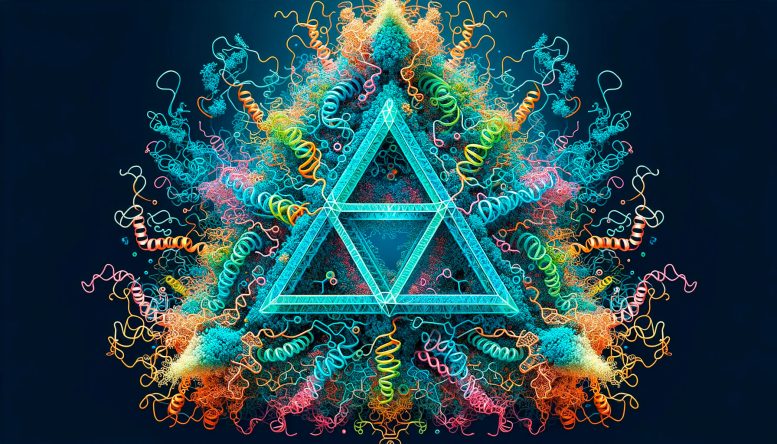
PicoRuler: Protein-based molecular rulers make it possible to test the optical resolution of the latest super-resolution microscopy methods on biomolecules in the sub-10-nanometer range under realistic conditions. Credit: Gerti Beliu, DALL-E 3 / University of Würzburg
Good news for researchers working with high-resolution fluorescence microscopy: Biocompatible molecular rulers are available for the first time to calibrate the latest super-resolution microscopy methods.
Recent advancements in super-resolution microscopy now enable an optical resolution of a few nanometers, comparable to the size of cellular molecules. Yet, verifying this resolution on cellular components like multiprotein complexes has been challenging due to the absence of biomolecular reference systems capable of precise dye labeling at nanometer-scale distances.
Innovative Biomolecular Tools: PicoRulers
A team of scientists led by Dr. Gerti Beliu and Professor Markus Sauer from the Rudolf Virchow Centre – Center for Integrative and Translational Bioimaging at Julius-Maximilians-Universität (JMU) Würzburg in Bavaria, Germany, has now provided a turning point. In the journal Advanced Materials, they present novel biocompatible molecular rulers, the PicoRulers (Protein-based Imaging Calibration Optical Rulers).
Using genetic code expansion and click chemistry, the team has succeeded in constructing these customized molecular rulers. They can be used as precise biomolecular reference structures in fluorescence microscopy.
Technological Masterpiece: Precision at the Molecular Scale
The PicoRulers are based on the three-part protein PCNA (Proliferating Cell Nuclear Antigen), which plays a central role in
Amino acids are a set of organic compounds used to build proteins. There are about 500 naturally occurring known amino acids, though only 20 appear in the genetic code. Proteins consist of one or more chains of amino acids called polypeptides. The sequence of the amino acid chain causes the polypeptide to fold into a shape that is biologically active. The amino acid sequences of proteins are encoded in the genes. Nine proteinogenic amino acids are called “essential” for humans because they cannot be produced from other compounds by the human body and so must be taken in as food.
” data-gt-translate-attributes='[{“attribute”:”data-cmtooltip”, “format”:”html”}]’>amino acids at precisely defined positions, this protein has been modified in such a way that fluorescent dyes or other molecules can be specifically clicked onto it with minimal linkage error.
This enables researchers to test the resolution of the latest super-resolution microscopy methods with unprecedented precision on a precisely defined cellular biomolecule.
Markus Sauer is enthusiastic: “The ability to resolve real biological structures at sub-10-nanometer level marks a new era in biological imaging. Compared to previously used artificial macromolecules, our PicoRulers are not only characterized by their biological compatibility. They also enable unrivaled precision for testing resolution under realistic conditions.”
Expanding Research Horizons: Cellular Processes Unveiled
The application of this technology extends far beyond the traditional boundaries of microscopy. “Our PicoRulers are not only a tool for more precise measurements, but also open the door to a deeper and more detailed investigation of complex processes that take place within our cells,” explains Gerti Beliu.
Future Implications: Transforming Biological Imaging
The further development of the PicoRulers may change biological and medical imaging with molecular resolution in the long term. For the first time, they make it possible to validate and improve the resolution potential of new super-resolution microscopy methods on biological samples. This makes them a valuable tool for the future elucidation of the molecular organization and interaction of biomolecules in cells.
Reference: “Pcna as Protein-Based Nanoruler for Sub-10 Nm Fluorescence Imaging” by Dominic A. Helmerich, Made Budiarta, Danush Taban, Sören Doose, Gerti Beliu and Markus Sauer, 27 November 2023, Advanced Materials.DOI: 10.1002/adma.202310104
